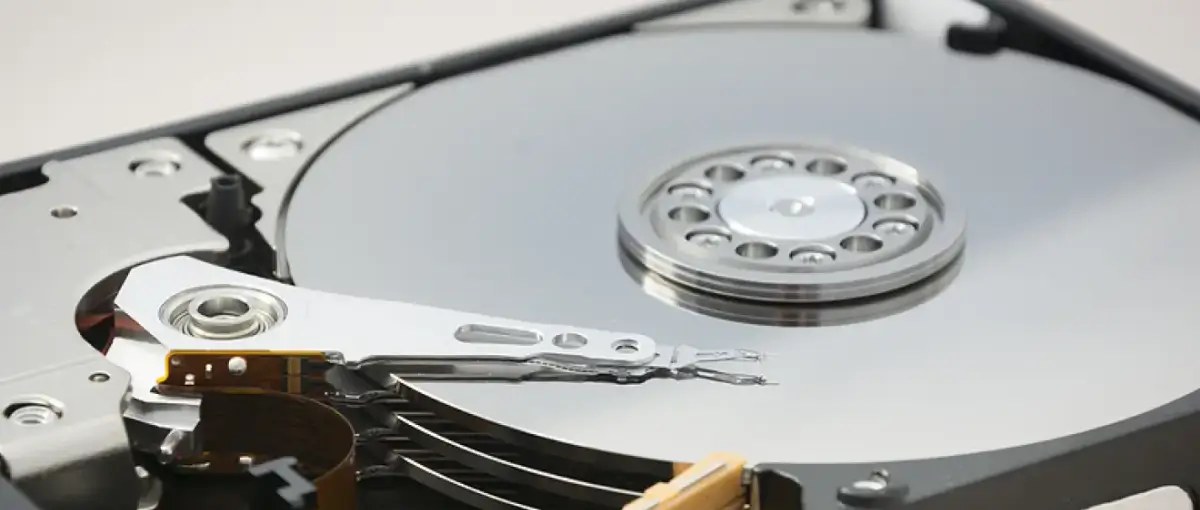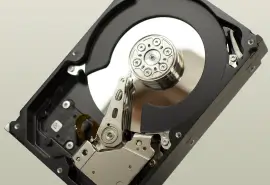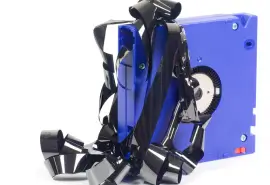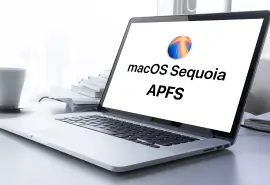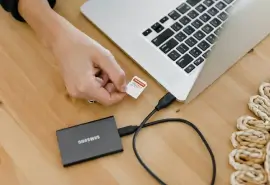Modern PCB architecture for HDD storage devices has changed. A fried or damaged PCB could in past years be swapped with a replacement from a donor board. New advances in drive technology have made PCB swaps much more complicated and elevated the risk of permanent data loss. If you experience data loss from a damaged or failed PCB, contact a professional data recovery service before taking matters into your own hands.
Introduction
IBM introduced the first commercial hard disk drive in 1956. It contained 50 24-inch platters,held about 5 MB of data, weighed more than a ton, and took up as much space as two refrigerators. The data storage industry has come a long way since then, with no end in sight. Each year, technology advances at an ever-increasing pace. The introduction of solid-state drives and continued development of new interfaces has further accelerated the growth of digital storage technology by offering users faster performance and greater durability.
In fact, solid-state and solid-state hybrid drives have moved the needle so much that some industry pundits talk about HDD devices as they do about magnetic tape and other legacy storage systems. Dismissing HDDs as legacy devices fails to account for the fact that they remain unsurpassed in providing immediate storage capacity and reliability. Moreover, ongoing research continues to find new ways to improve these so-called outdated devices.
Active development by researchers and manufacturers continues to push the boundaries for capacity, speed, and device longevity. In 2021, English researchers at Cambridge University announced that they replaced the traditional carbon coating on HDD platters with a layer of graphene. This “super material” is just one atom in width, highly conducive, flexible, and more than 100 times stronger than steel.
The broader applications for graphene, including in consumer electronics, structural engineering, and aerospace, are only now being discovered. The Cambridge researchers found that when partnered with other recent advances in HDD manufacturing, including heat-assisted magnetic recording technology (HAMR) and HAMR+bit patterned media, graphene could push areal density in HDDs to between 4 and 10 TB per square inch. Most current HDDs have areal densities of 1 TB per square inch.
As HDD technology progresses, professional data recovery techniques have been forced to evolve as well to address new challenges. Increased HDD reliability and performance has created the unfortunate side effect that standard techniques for hard drive recovery, tested and refined over many years, no longer work in the same way they once did, and sometimes not at all. Advanced drive technology has complicated the process of successfully extracting a failed disk’s contents and in some cases prevented it entirely.
Perhaps the clearest example of this phenomenon involves the practice of swapping out printed circuit boards (PCB) in damaged HDD devices. Until quite recently, replacing damaged, defective, or malfunctioning PCBs with donor boards has been one of the more basic methods used in computer peripheral repair as well as professional data recovery to gain access to failed devices prior to data extraction. PCB swaps have now largely become an outmoded and counterproductive method that can pose a serious risk of permanent data loss.
PCB Swaps Prior to 2014
PCBs contain electrical pathways printed on an insulated substrate that control the movement of electrical current between components to support a hard drive’s functions. Until 2014, PCBs remained largely uniform components of hard disk construction. PCBs were effectively interchangeable; if it malfunctioned or became damaged, the PCB could be replaced with a precise match. Finding a suitable donor PCB became a standard fix for broken interfaces or power connectors, corrupt firmware, or other failed components of the PCB.
A PCB swap could also resolve some problems related to a hard drive’s Micro Controller Unit (MCU) or Voice Coil Motor (VCM). The MCU is generally the largest chip on the PCB and controls how and where all data is stored on the drive, while the VCM controls the rotation of the spindle motor and the movement of the read/write heads. Prior to 2014, data unique to a specific hard disk was only stored upon its magnetic platters. As long as the PCB was the root cause of failure, replacing it with a transplant could easily restore drive functions without affecting any stored information.
Modern Advances in PCB Architecture
First introduced in 2014, evolving hard disk technologies require changes in the way modern PCBs are constructed. For example, the MCU is now a fully-featured Central Processing Unit with its own dedicated RAM and storage. The MCU has so many sophisticated features that it essentially serves as a “computer within a computer.” This and other technical innovations make hard drives far too complex to store unique information about the disk solely on the platters.
Increased areal density and new recording processes now require calibration settings that are unique to each disk. Preamplifier gains and thermal flying height control are recorded at two different temperatures. Manufacturers also tune track densities to the specific performance characteristics of individual write heads. Additional information, unique to each manufacturer’s own construction and calibration routines, are ultimately computed and stored within the new components of each PCB.
What impact does this have on the ability to successfully swap out a damaged PCB? Individual platters in current models of hard drives, as well as the tracks within the platters, are likely to have different settings. Unlike pre-2014 hard drive models, modern PCB assemblies cannot recreate calibration settings outside of the manufacturing environment. This means that a transplanted PCB will be entirely useless as a replacement for a hard drive’s damaged or malfunctioning PCB.
Troubling Statistics for PCB Data Recovery
The technicians at Secure Data Recovery Services have noticed in recent years that knowledge about modern hard drive manufacturing among consumers, computer enthusiasts, and even some professional data recovery providers remains scarce. Evidence for this can be found in the number of data recovery cases we continue to receive in which a user has attempted a PCB swap with the assistance of a YouTube video or other online forms of DIY advice. Any such attempt, as has been previously noted, will not work.
If you use a hard drive manufactured in 2014 or later that fails as a result of a damaged or faulty PCB, performing a PCB swap to resolve the issue will in every instance lead to the permanent loss of whatever data is stored on that drive. Even a professional data recovery service will not be able to help you unless you retain the original board. Technicians too often see modern drives come in with missing PCBs because the user or another data recovery firm tried a board swap.
PCB Swap Data Recovery Is Possible When It’s Done Right
Hard drive technology has evolved to the point where data recovery techniques once considered routine in the industry no longer work. In fact, attempting them can lead more often than not to permanent data loss. This is now the case with PCB swaps. Any successful data recovery from a hard disk with a damaged or malfunctioning PCB requires the original PCB. Any attempt to swap the board with a donor PCB, even one from the same manufacturer or the exact brand, will fail and make any data recovery from the drive impossible.
Professional data recovery firms such as Secure Data Recovery Services have developed new approaches to old problems. These custom solutions take into account the rapid advancement of technical innovation. Data loss as a result of damaged or malfunctioning PCBs on modern HDD devices can be resolved using the original board. Data recovery engineers can repair the operating system on the damaged PCB, diagnose and replace failed components, and even transplant the necessary components to a donor PCB. However, none of this is possible if the original PCB has been discarded.
Secure Data Recovery Services invests heavily in research and development that helps recovery techniques keep pace with innovations in hard drive technology. As manufacturers find even more creative ways to improve the capacity, performance, and longevity of hard drives, data recovery engineers must be equally as creative in finding the most effective solutions for data loss when these devices fail. And sadly, all devices eventually fail. Having a data recovery partner with the right background and technical experience will determine if that data loss is temporary or permanent.
Conclusions
Secure Data Recovery Services has pioneered numerous advanced data recovery techniques since its inception in 2007. Our research and development department invests heavily in the creation of advanced tools and utilities to meet each new challenge that rapid technological evolution presents. In many cases, such as hard drive PCB failures, our customers play an essential role in determining the overall success of a data recovery case.
Data loss as a result of PCB failure accounts for only a small portion of our data recovery cases – just about 5% of all hard drive recovery cases we receive in any given year. However, data loss caused by PCB failures is guaranteed to be permanent in 100% of such cases if our engineers do not have access to the original hard drive PCB.
Hard drives manufactured after 2014 do not support PCB transplants. Board components now contain unique data that controls operations specific to that drive. Replacing a damaged PCB with a donor board from another drive of the same brand and model is no longer an option. It will result in total and permanent data loss in every instance.
However, In better than 96% of PCB failure cases in which our engineers have access to the original board, we are able to successfully recover all lost data. Moreover, our technicians have created custom procedures that allow us to transplant chips from donor boards to the original PCB to facilitate data recovery and extraction with a better than 70% success rate in cases where the original board has sustained critical damage.
Storage drive technology continues to evolve as the need for greater capacities and higher read/write access speeds grows. There is little doubt that this evolution will make other data recovery techniques less effective or even entirely redundant. Secure Data Recovery Services continues to adapt to the changing technological landscape to ensure that we can offer customized and effective data recovery solutions now and in the years to come.

